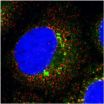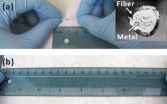(Press-News.org) WASHINGTON, Dec. 18, 2012 — For everyone with holiday visions of snowflakes dancing in their heads, the American Chemical Society, the world's largest scientific society, today issued a video explaining how dust, water, cold and air currents collaborate to form these symbols of the season. It's all there in an episode of Bytesize Science, the award-winning video series produced by the ACS Office of Public Affairs at www.BytesizeScience.com.
The video tracks formation of snowflakes from their origins in bits of dust in clouds that become droplets of water falling to Earth. When the droplets cool, six crystal faces form because water molecules bond in hexagonal networks when they freeze. It explains that ice crystals grow fastest at the corners between the faces, fostering development of the six branches that exist in most snowflakes. As snowflakes continue to develop, the branches can spread, grow long and pointy, or branch off into new arms. As each snowflake rises and falls through warmer and cooler air, it thus develops its own distinctive shape.
###For more entertaining, informative science videos and podcasts from the ACS Office of Public Affairs, view Prized Science, Spellbound, Science Elements and Global Challenges/Chemistry Solutions.
The American Chemical Society is a nonprofit organization chartered by the U.S. Congress. With more than 164,000 members, ACS is the world's largest scientific society and a global leader in providing access to chemistry-related research through its multiple databases, peer-reviewed journals and scientific conferences. Its main offices are in Washington, D.C., and Columbus, Ohio.
To automatically receive news releases from the American Chemical Society, contact newsroom@acs.org.
Follow us: Twitter | Facebook
Visions of snowflakes: An American Chemical Society holiday video
2012-12-18
ELSE PRESS RELEASES FROM THIS DATE:
Mistaking OCD for ADHD has serious consequences
2012-12-18
On the surface, obsessive compulsive disorder (OCD) and attention deficit/hyperactivity disorder (ADHD) appear very similar, with impaired attention, memory, or behavioral control. But Prof. Reuven Dar of Tel Aviv University's School of Psychological Sciences argues that these two neuropsychological disorders have very different roots — and there are enormous consequences if they are mistaken for each other.
Prof. Dar and fellow researcher Dr. Amitai Abramovitch, who completed his PhD under Prof. Dar's supervision, have determined that despite appearances, OCD and ACHD ...
Spread of cancer cells may be slowed by targeting of protein
2012-12-18
HERSHEY, Pa.--The spread of cancer cells may be slowed by targeting the protein km23-1, according to researchers at Penn State College of Medicine.
A motor protein that transports cargo within the cell, km23-1 is also involved in the movement or migration of cells. Migration is necessary for cancer to spread, so understanding this cell movement is important for development of better cancer treatments.
Kathleen Mulder, Ph.D., professor, biochemistry and molecular biology, looked for partner proteins that bind to and cooperate with km23-1 during cell movement, which ...
UNC researchers discover how hepatitis C virus reprograms human liver cells
2012-12-18
Chapel Hill, NC – CHAPEL HILL – Hepatitis C virus has evolved to invade and hijack the basic machinery of the human liver cell to ensure its survival and spread. Researchers at the University of North have discovered how hepatitis C binds with and repurposes a basic component of cellular metabolism known as a microRNA to help protect and replicate the virus.
In a paper published online in the Proceedings of the National Academy of Sciences Dec. 17, researchers in the laboratory of Stanley M. Lemon, MD, professor of medicine and microbiology and immunology and member of ...
Long-terms benefits follow brain surgery for certain forms of epilepsy
2012-12-18
DETROIT – Brain surgery for certain difficult forms of epilepsy often reduces or eliminates seizures for more than 15 years after the procedure, according to new research by neurologists at Henry Ford Hospital.
Drugs are not effective in controlling seizures in 30 out of 100 people with epilepsy, and resective surgery is the most common alternative treatment. During resective surgery, the portion of the brain responsible for the seizures is removed, usually reducing their frequency and sometimes eliminating them.
"Our study shows that a significant number of patients ...
Long-term survival after less-invasive repair of abdominal aneurysm same as with 'open' procedure
2012-12-18
Despite earlier signs that a less-invasive surgery is safer and better than "open" operations to repair potentially lethal abdominal aortic aneurysms, a study led by a Johns Hopkins professor shows survival rates after four years are similar for both procedures.
In an extended follow-up of patients in the OVER (Open Versus Endovascular Repair) Trial, researchers found that, contrary to expectations, the two procedures carried about the same long-time survival after four years, even though survival was higher in the endovascular group at the two-year mark. Moreover, among ...
Reproductive Health Matters announces publication of its themed issue
2012-12-18
Amsterdam, December 18, 2012 - Sexual and reproductive morbidities are not a priority in health policy. They do not feature among donors favourite health initiatives and remain outside the global health agenda. In many parts of the world practice is stubbornly failing to catch up with national policies, leaving shortfalls in every area of care. This, despite the enormous impact such morbidities have on the lives of women, men and their families, is something that is illustrated in a number of papers published in the latest issue of Reproductive Health Matters (RHM) which ...
Evidence insufficient to recommend routine antibiotics for joint replacement patients
2012-12-18
Rosemont, Ill. - The American Academy of Orthopaedic Surgeons (AAOS), and the American Dental Association (ADA) found that there is insufficient evidence to recommend the routine use of antibiotics for patients with orthopaedic implants to prevent infections prior to having dental procedures because there is no direct evidence that routine dental procedures cause prosthetic joint infections.
The AAOS and ADA's recommendations are based on a collaborative evidence-based clinical practice guideline that focuses on the possible linkage between orthopaedic implant infection ...
Study of pipestone artifacts overturns a century-old assumption
2012-12-18
CHAMPAIGN, lll. — In the early 1900s, an archaeologist, William Mills, dug up a treasure-trove of carved stone pipes that had been buried almost 2,000 years earlier. Mills was the first to dig the Native American site, called Tremper Mound, in southern Ohio. And when he inspected the pipes, he made a reasonable – but untested – assumption. The pipes looked as if they had been carved from local stone, and so he said they were. That assumption, first published in 1916, has been repeated in scientific publications to this day. But according to a new analysis, Mills was wrong.
In ...
Researchers use liquid metal to create wires that stretch 8 times their original length
2012-12-18
Researchers from North Carolina State University have created conductive wires that can be stretched up to eight times their original length while still functioning. The wires can be used for everything from headphones to phone chargers, and hold potential for use in electronic textiles.
To make the wires, researchers start with a thin tube made of an extremely elastic polymer and then fill the tube with a liquid metal alloy of gallium and indium, which is an efficient conductor of electricity.
"Previous efforts to create stretchable wires focus on embedding metals ...
Reappraisal defuses strong emotional responses to Israel-Palestine conflict
2012-12-18
Reappraisal is a widely-used cognitive strategy that can help people to regulate their reactions to emotionally charged events. Now, new research suggests that reappraisal may even be effective in changing people's emotional responses in the context of one of the most intractable conflicts worldwide: the Israeli-Palestinian conflict.
"Negative intergroup emotions play a crucial role in decisions that perpetuate intractable conflicts," observes lead researcher Eran Halperin of the New School of Psychology at the Interdisciplinary Center in Israel.
With this in mind, ...


